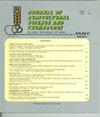玉米抗粉螟和甘蔗螟虫基因型的选择
IF 1.3
4区 农林科学
Q2 AGRICULTURE, MULTIDISCIPLINARY
Journal of Agricultural Science and Technology
Pub Date : 2015-01-01
DOI:10.17265/2161-6256/2015.03.003
引用次数: 0
摘要
玉米是尼日利亚一种重要的经济作物。其生产受到尼日利亚东南部特有的粉红茎螟- sesamia calamistis (Hampson,夜蛾科)和甘蔗螟- eldana saccharina (Walker, Pyralidae)的显著影响。在有压力的地区,现有的基因型由于其固有的能力,可能表现得稍好一些。因此,有可能在这些受胁迫的地区找到有用的基因,因为这些基因多年来一直负责寄主作物的存活。对尼日利亚东南部209个地方玉米和3个改良对照品种的一系列农艺性状和抗性特性进行了评价研究。2001年在四个环境下的三个地点进行了现场试验。在所有性状中都发现了高度显著的基因型差异,这表明基因型之间存在着巨大的差异,从而为选择理想性状提供了机会。在此基础上,利用不同环境下的叶片摄食、穗损、茎秆倒伏和产量4个性状构建了等级综合指数(RSI),并利用该指数对水稻茎秆螟虫抗性进行排序。RSI鉴定出了11个基因型,占212个基因型中抗性最强的5%。基因型AMA TZBR-WC1(来自伊巴丹国际热带农业研究所)的总体抗性水平最高,其次是基因型SE NG-77和SE NG-67(来自乌穆阿希亚北部)、SE NG-62(来自伊库瓦诺)、SE NG-148(来自乌克瓦西部)、SE NG-106(来自本德)、SE NG-119(来自伊伊阿拉-恩瓦)、SE NG-33(来自伊库瓦诺)和SE NG-65(来自乌穆阿希亚北部)。本文章由计算机程序翻译,如有差异,请以英文原文为准。
Selection of Maize Genotypes Resistant to Pink Stem Borer and Sugarcane Borer
Maize is an important economic crop grown in Nigeria. Its production is dramatically affect by the pink stem borer—Sesamia calamistis (Hampson, Noctuidae) and sugarcane borer—Eldana saccharina (Walker, Pyralidae) that are endemic in Southeastern Nigeria. In areas of stress, existing genotypes may marginally do well due to their inherent capabilities. Therefore, it is possible to find useful genes in such areas of stress, since such genes have been responsible for the survival of host crops over the years. Evaluation study was conducted for a range of agronomic characteristics and resistance attributes for 209 local maize collections from Southeastern Nigeria along with three improved check varieties. Field trials were conducted at three locations in a total of four environments in 2001. Highly significant genotypic variances as were noted in all the traits, are indicative of the magnitude of variation that exists among the genotypes, thus providing the opportunity of selection for desirable traits. Furthermore, four traits, namely, leaf feeding, ear damage, stalk lodging and yield were used from across the environments to construct a rank summation index (RSI), which was used to rank the entries for resistance to stem borers. This RSI led to the identification of 11 genotypes which represents the best 5% of the 212 genotypes in resistance ability. Genotype AMA TZBR-WC1 (from International Institute of Tropical Agriculture (IITA), Ibadan) had the best overall resistance levels, followed by genotypes SE NG-77 and SE NG-67 (from Umuahia North), SE NG-62 (from Ikwuano), SE NG-148 (from Ukwa West), SE NG-106 (from Bende), SE NG-119 (from Isiala Ngwa), SE NG-33 (from Ikwuano) and SE NG-65 (from Umuahia North).
求助全文
通过发布文献求助,成功后即可免费获取论文全文。
去求助
来源期刊

Journal of Agricultural Science and Technology
AGRICULTURE, MULTIDISCIPLINARY-
CiteScore
1.90
自引率
8.30%
发文量
0
审稿时长
4.5 months
期刊介绍:
Journal of Agricultural Science and Technology is one of the TMU Press journals that is published by the responsibility of its Editor-in-Chief and Editorial Board in the determined scopes.
Journal of Agricultural Science and Technology (JAST) is an international research journal published bimonthly for the purpose of advancing the scientific studies. The subjects covered by JAST include all aspects of agriculture and natural resources (see Areas Covered). The journal will consider submissions from all over the world, on research works not being published or submitted for publication towards publication as full paper, review article and research note. The Papers are published in English with an extra abstract in Persian.
 求助内容:
求助内容: 应助结果提醒方式:
应助结果提醒方式:


